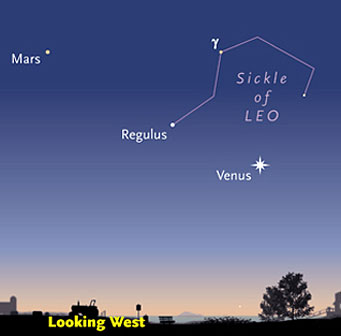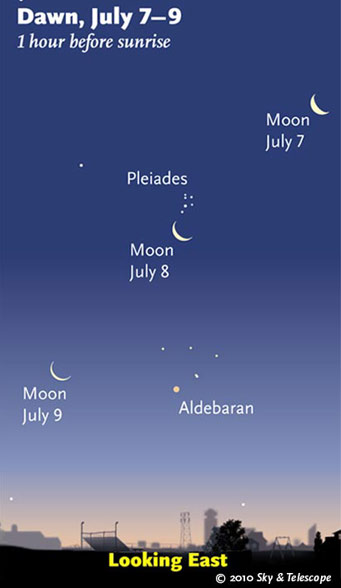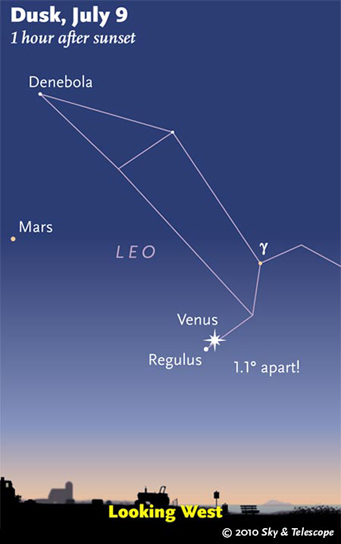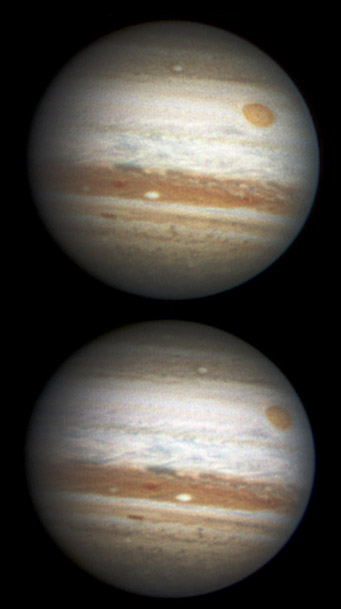
The week begins with Venus and Regulus still fairly far apart. . . .
Sky & Telescope diagram
Friday, July 2
Saturday, July 3
Sunday, July 4
Meanwhile, Vega is the bright star very high in the east. Arcturus is the bright star very high in the southwest.

Early risers can watch the waning crescent Moon pass the "fall and winter" Pleiades and Aldebaran during summer.
Sky & Telescope diagram
Monday, July 5
Tuesday, July 6
Wednesday, July 7
Thursday, July 8

. . . but by July 9th Regulus closes right in on Venus.
Sky & Telescope diagram
Friday, July 9
Saturday, July 10
Want to become a better amateur astronomer? Learn your way around the constellations. They're the key to locating everything fainter and deeper to hunt with binoculars or a telescope.
For an easy-to-use constellation guide covering the whole evening sky, use the big monthly map in the center of each issue of Sky & Telescope, the essential magazine of astronomy. Or download our free Getting Started in Astronomy booklet (which only has bimonthly maps).

The Pocket Sky Atlas plots 30,796 stars to magnitude 7.6 — which may sound like a lot, but that's less than one star in an entire telescopic field of view, on average. By comparison, Sky Atlas 2000.0 plots 81,312 stars to magnitude 8.5, typically one or two stars per telescopic field. Both atlases include many hundreds of deep-sky targets — galaxies, star clusters, and nebulae — to hunt among the stars.
Sky & Telescope
Once you get a telescope, to put it to good use you must have a detailed, large-scale sky atlas (set of charts). The standards are the Pocket Sky Atlas, which shows stars to magnitude 7.6; the larger Sky Atlas 2000.0 (stars to magnitude 8.5); and the even larger and deeper Uranometria 2000.0 (stars to magnitude 9.75). And read how to use your charts effectively.
You'll also want a good deep-sky guidebook, such as Sky Atlas 2000.0 Companion by Strong and Sinnott, or the more detailed and descriptive Night Sky Observer's Guide by Kepple and Sanner or the classic if dated Burnham's Celestial Handbook.
Can a computerized telescope take their place? I don't think so — not for beginners, anyway, and especially not on mounts that are less than top-quality mechanically. As Terence Dickinson and Alan Dyer say in their Backyard Astronomer's Guide, "A full appreciation of the universe cannot come without developing the skills to find things in the sky and understanding how the sky works. This knowledge comes only by spending time under the stars with star maps in hand."
This Week's Planet Roundup
Mercury (about magnitude –1.5) is very deep in the glow of sunset. Late in the week, scan for it with binoculars shortly after sundown just above the horizon far to the lower right of Venus.
Venus (magnitude –4.0, in Leo) is the bright Evening Star sinking in the west as twilight fades. Look a little to Venus's upper left for much fainter Regulus (magnitude +1.4) closing in on Venus day by day. They pass each other on July 9th and 10th hardly more than 1° apart.
In a telescope Venus is still a small (15-arcsecond) gibbous disk. You'll have the cleanest telescopic views of it when it's higher in the blue sky of afternoon — if you can find it then. (Don't accidentally sweep up the Sun!) Not until late summer will Venus assume its larger and more dramatic crescent phase.
Mars (magnitude +1.4, under the tail of Leo) is upper left of Venus and Regulus. Mars and Regulus are equally bright. Watch Mars closing in on Saturn to its upper left.
In a telescope Mars is just a very tiny blob, 5 arcseconds in diameter.

Jupiter's Great Red Spot is still floating free in the absence of the South Equatorial Belt. Christopher Go took the bottom image at 20:32 UT June 25th, and the top image 24 later earlier. South is up.
Jupiter (magnitude –2.5, in Pisces) rises around midnight daylight saving time and shines high in the southeast before dawn. It's the brightest starlike point in the morning sky. See our article on Jupiter's disappearing South Equatorial Belt.
Jupiter's Great Red Spot is near System II longitude 150°. Assuming it stays there, here's a list of all the Great Red Spot's predicted transit times for the rest of 2010.
Saturn (magnitude +1.1, in the head of Virgo) is in the west during evening, upper left of Mars. The diagonal line of Saturn, Mars, Regulus, and Venus is shrinking; the three planets will bunch up low in the sunset in early August. A telescope shows Saturn's rings a mere 2° from edge-on.
Uranus (magnitude 5.8, in Pisces) is about 2° from Jupiter. In a telescope Uranus is only 3.6 arcseconds wide, compared to Jupiter's 41″.
Neptune (magnitude 7.9, at the Aquarius-Capricornus border) is in good view during early morning hours well to Jupiter's west. See our finder charts for Uranus and Neptune in 2010.
Pluto (magnitude 14, in northwestern Sagittarius) is high in the south-southeast by 11 or midnight. See our big Pluto finder charts for 2010.
All descriptions that relate to your horizon or zenith — including the words up, down, right, and left — are written for the world's mid-northern latitudes. Descriptions that also depend on longitude (mainly Moon positions) are for North America. Eastern Daylight Time (EDT) equals Universal Time (also known as UT, UTC, or GMT) minus 4 hours.
To be sure to get the current Sky at a Glance, bookmark this URL:
http://SkyandTelescope.com/observing/ataglance?1=1
If pictures fail to load, refresh the page. If they still fail to load, change the 1 at the end of the URL to any other character and try again.
 0
0
Comments
You must be logged in to post a comment.